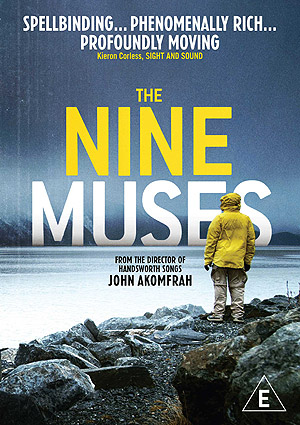
The Nine Muses

THE NINE MUSES (DOCUMENTARY)
New Wave Films
Release date: April 23rd, 2012
Running time: 90 minutes
Writer and director: John Akomfrah

Memory can present itself in different ways on screen; sometimes as a theme, through the use of flashbacks or as a plot device. In my experience, the most interesting attempt to visualise it was in Apichatpong Weerasethakul’s Syndromes And A Century (2006), a Thai art-house film. This experience closely resembles the one I had with John Akomfrah’s experimental ‘documentary’ The Nine Muses.
At 80 minutes into Syndromes And A Century, I finally abandoned my desire to form a conventional narrative from what I was seeing on screen, and the final 40 minutes were all the better for it. The Nine Muses is partly made up of stock footage of Britain from the 1960s and 70s, showing the weather, animals and traffic, but it’s also combined with immigrants in various situations; at work in menial jobs, at family parties or being interviewed. They tell us what life was like for people arriving in Britain from Africa, Asia or the Caribbean.
The rest of the film contains footage of faceless figures in large colourful coats wandering around and standing, looking at some beautiful Alaskan scenery. In addition to this visual collage are the poetry readings the make up the film’s soundtrack, taken from sources such as Homer, Joyce, Beckett and Thomas. As The Nine Muses moves through its chapters, each headed with the names of different muses from Greek myths, we hear gobbets from poems that serve to either support or juxtapose what we see on the screen – with varying success.
As with Syndromes And A Century, The Nine Muses should be approached as something other than a conventional film. Its aim is not to inform but to present what life was like for immigrants in a way that cares little for how abstract it is. As a result, it wouldn’t be out of place in an art gallery as installation. Although there was a sense of atmosphere and it was visually stunning, The Nine Muses left me confounded, even after I stopped trying to figure out the meaning of the images and prose. I struggled to understand what Akomfrah wanted to say with the film and about immigrants living in Britain during that time.
I might not have taken anything substantial from the film, but it was still interesting to see how Akomfrah chose to present memory on screen and the few insights he gave.

Ben Nicholson
Ben has had a keen love of moving images since his childhood but after leaving school he fell truly in love with films. His passion manifests itself in his consumption of movies (watching films from all around the globe and from any period of the medium’s history with equal gusto), the enjoyment he derives from reading, talking and writing about cinema and being behind the camera himself having completed his first co-directed short film in mid-2011.
His favourite films include things as diverse as The Third Man, In The Mood For Love, Badlands, 3 Iron, Casablanca, Ran and Grizzly Man to name but a few.
Ben has his own film site, ACHILLES AND THE TORTOISE, and you can follow him on Twitter @BRNicholson.
© 2022 STATIC MASS EMPORIUM . All Rights Reserved. Powered by METATEMPUS | creative.timeless.personal. | DISCLAIMER, TERMS & CONDITIONS
HOME | ABOUT | CONTACT | TWITTER | GOOGLE+ | FACEBOOK | TUMBLR | YOUTUBE | RSS FEED
CINEMA REVIEWS | BLU-RAY & DVD | THE EMPORIUM | DOCUMENTARIES | WORLD CINEMA | CULT MOVIES | INDIAN CINEMA | EARLY CINEMA
MOVIE CLASSICS | DECONSTRUCTING CINEMA | SOUNDTRACKS | INTERVIEWS | THE DIRECTOR’S CHAIR | JAPANESE CINEMA





